If you’re a history buff, fascinated by larger-than-life figures, or just love exploring under-visited, grand architectural masterpieces, Napoleon’s tomb at Les Invalides in Paris is a must-visit for you!
This is no plain old grave—it’s an enormous monument to one of the most ambitious, self-aggrandizing, and controversial figures in all of recorded history. From its magnificent golden dome to the massive red sarcophagus that holds the Emperor Napoleon Bonaparte’s remains, everything about this site hits you in the face with power, legacy, and more than a bit of wow factor. Napoleon didn’t design the tomb, but he certainly would have loved it. And there are absolutely no photos that do it justice.
Let’s dive into the details so you have all the information you need to visit this colossal monument!
Where is Napoleon’s Tomb?
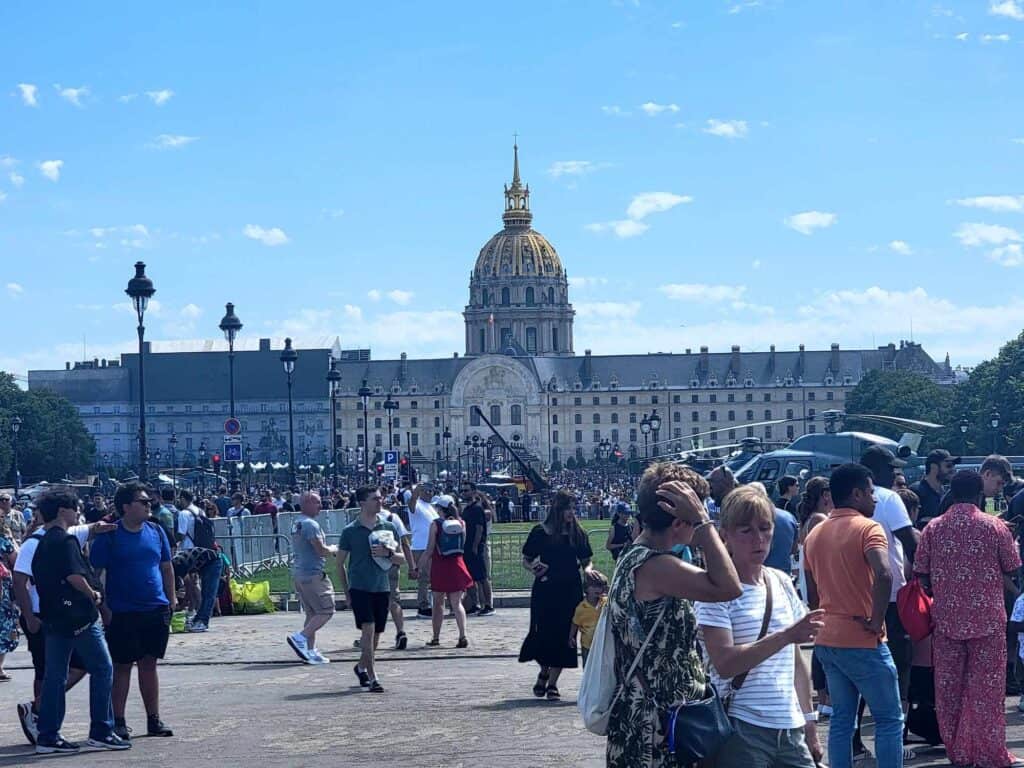
Hôtel des Invalides, 129 Rue de Grenelle, 75007 Paris, France
Napoleon’s final resting place is inside the Dôme des Invalides, an incredible golden-domed church that is part of the Hôtel National des Invalides, located in the 7th arrondissement (district) of Paris.
The entire complex was originally built in the 17th century by Louis XIV as a hospital and retirement home for war veterans—hence the name “Invalides.” And France had a lot of war veterans.
It was also stormed at the beginning of the French Revolution on July 14, 1789, and the cannons which were stored in the basement were used against the Bastille later that day!
Today the complex houses the Musée d’Armée, and the courtyard recently hosted the individual fencing competition for the Paris 2024 Olympic Games.
How to Get to Les Invalides

🚈 By Metro
The most convenient way to reach Les Invalides is by metro:
- Line 8 or Line 13 – Stop: Invalides (a very short walk from the entrance to the Dôme)
- RER C – Stop: Invalides (the RER comes from further outside the city)
🚗 By Car
Driving in Paris isn’t for the faint of heart, but if you’re determined to take the challenge:
- There is a paid underground parking lot at 23 Rue de Constantine, near the Invalides complex.
- Street parking is very limited in this area, so public transport or walking is usually the better option.
How Did Napoleon’s Body Get to Les Invalides
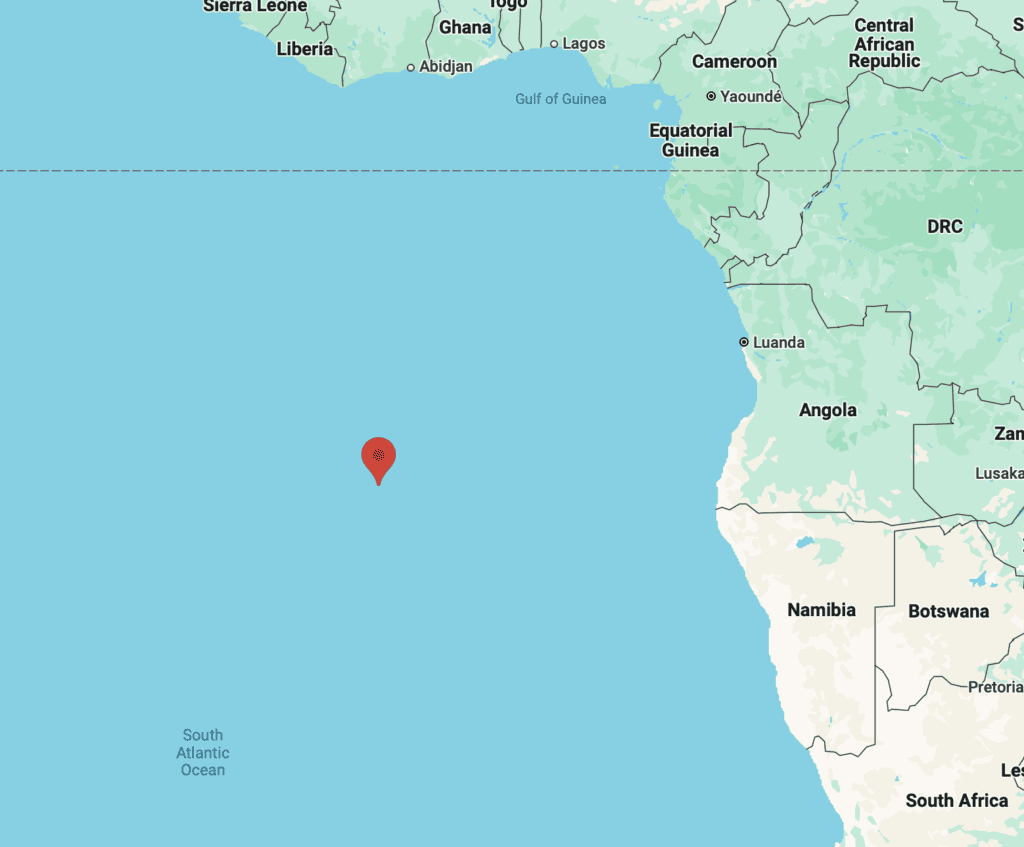
Napoleon’s body wasn’t always buried with such grandeur. Originally, after his death in 1821, he was buried in the “Valley of the Willows” on the remote British island of Saint Helena in the Southern Atlantic. The island is about 1200 miles (1,950 km) west of Angola in Africa. Napoleon was exiled there after his defeat at the Battle of Waterloo in Belgium. They were not taking any chances since Napoleon returned after his first exile and wreaked havoc. Fool me once… etc.
In 1840, nearly 20 years after his death, and after a lot of negotiating by King Louis-Philippe, his remains were returned to Paris, although you can still visit the original empty tomb if you ever happen to make it to St. Helena.
Upon his return he was given a grand state funeral, and his coffin was carried through the city in a massive procession before being interred at Les Invalides in a temporary tomb. His current sarcophagus wasn’t completed until 1861 under Napoleon III (his nephew).
The Dôme des Invalides
The Dôme des Invalides is truly one of the most striking buildings in all of Paris. Its golden dome (yes, it’s real gold leaf!) reaches over 300 feet high (107 meters) and is almost blinding in the sunlight. It was originally designed as a royal chapel in the late 17th century, but has been transformed into Napoleon’s grand mausoleum. And grand it is!
I don’t know why more people don’t visit, but if they’re like me they didn’t realize the size and scope of the mausoleum, or the incredible amount of history to explore in the museum. I purposely posted photos with people in them because I think part of the reason you don’t get a sense of scale is because there are often photo posted with no humans in them.
The Rotunda and Napoleon’s Sarcophagus
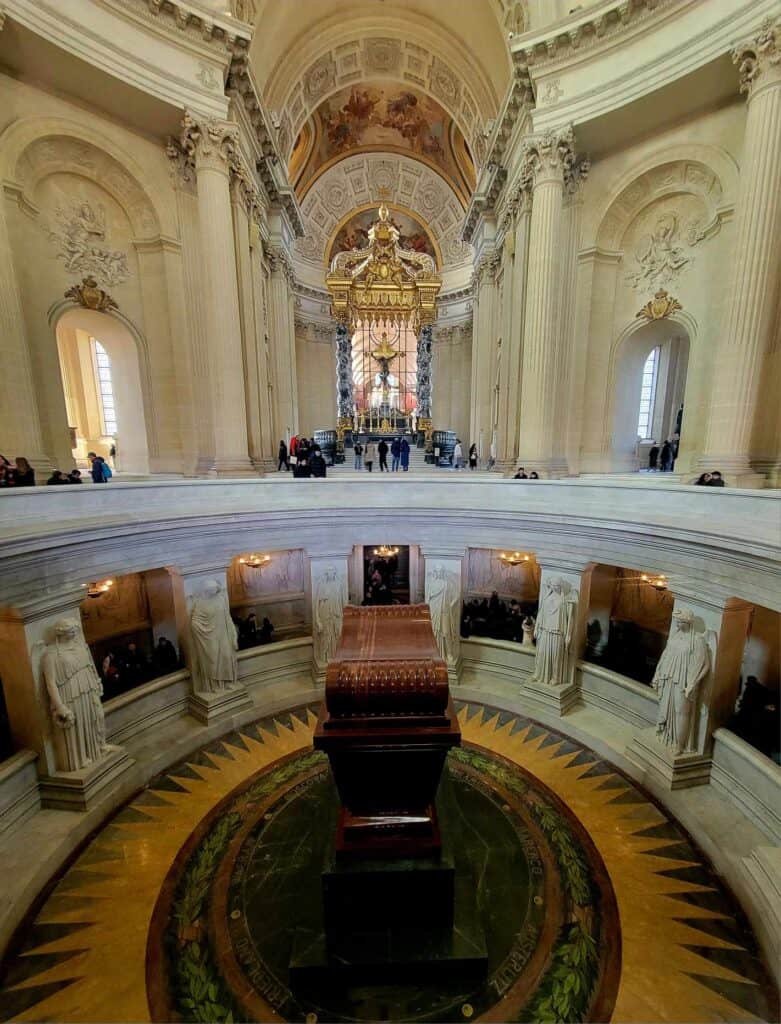
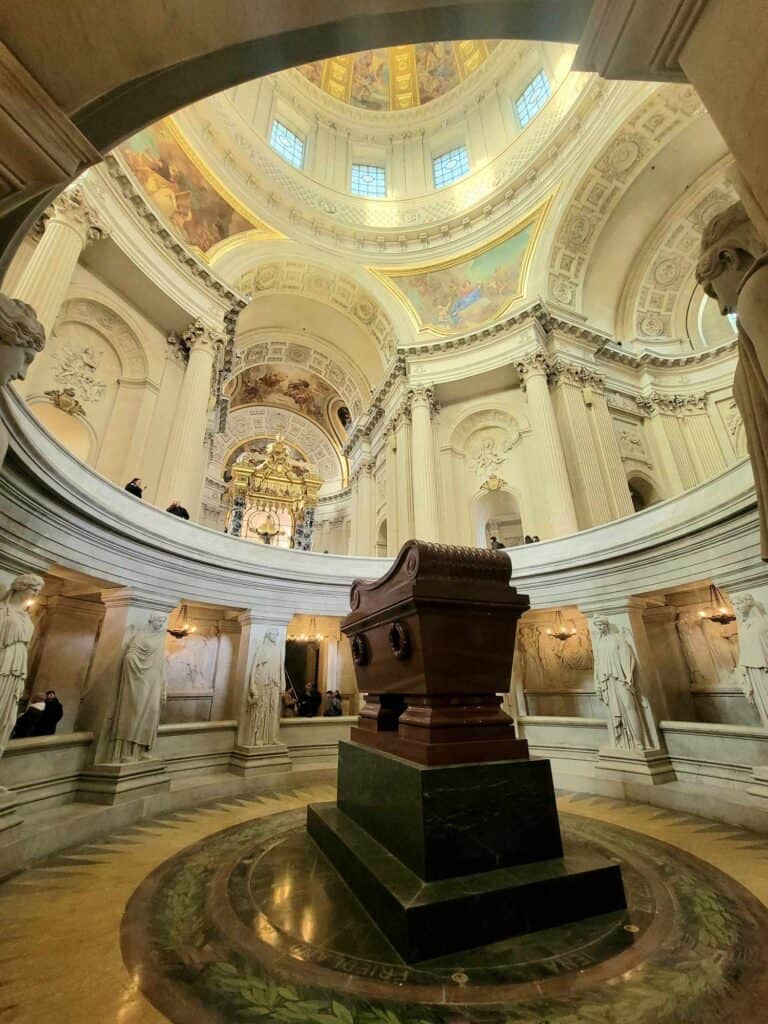
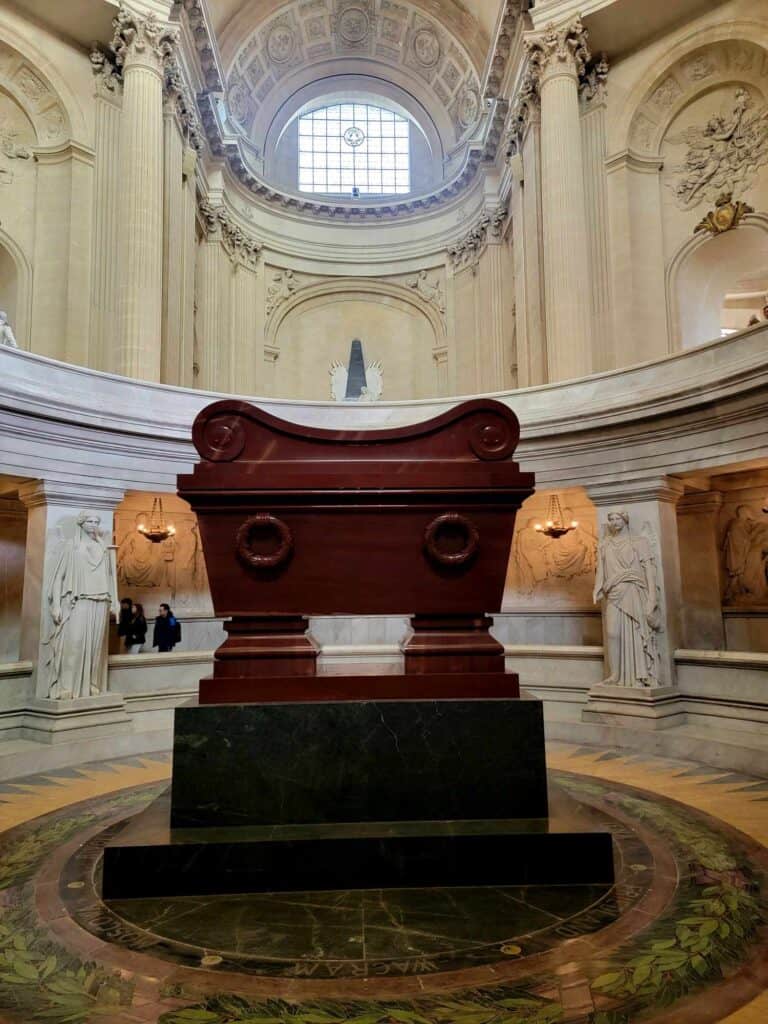
The most startling thing about Napoleon’s sarcophagus is it’s absolutely massive size. We all know that Napoleon was known for his small stature, but the process of his burial makes his final resting spot anything but small! The sarcophagus measures 16 feet (4.9 meters) long, 7 feet wide (2.1 meters) wide, and 14 feet (4.3 meters) high! And all of that rests on a huge green granite base.
And if you’re wondering why so huge, he’s resting in not just one coffin, but in six nested coffins, all made of different materials:
- Napoleon – the tiny ‘nesting doll’ at the center on a silk pillow surrounded by cotton
- Tin
- Mahogany
- Lead
- Another layer of mahogany
- Ebony
- Red quartzite – the final outer sarcophagus you see.
But wait, there’s more! Twelve massive white marble female statues, known as ‘The Victories,’ encircle the tomb. They symbolize Napoleon’s military triumphs. Each is different and they all stare forlornly at his sarcophagus. On the floor around Napoleon’s tomb is a marble inlay pattern with points radiating like the sun, and a ring of laurel leaves used to symbolize victory. Around the outside of the rotunda, giant relief carvings depict his most significant achievements.
Who Else is Buried at Les Invalides?
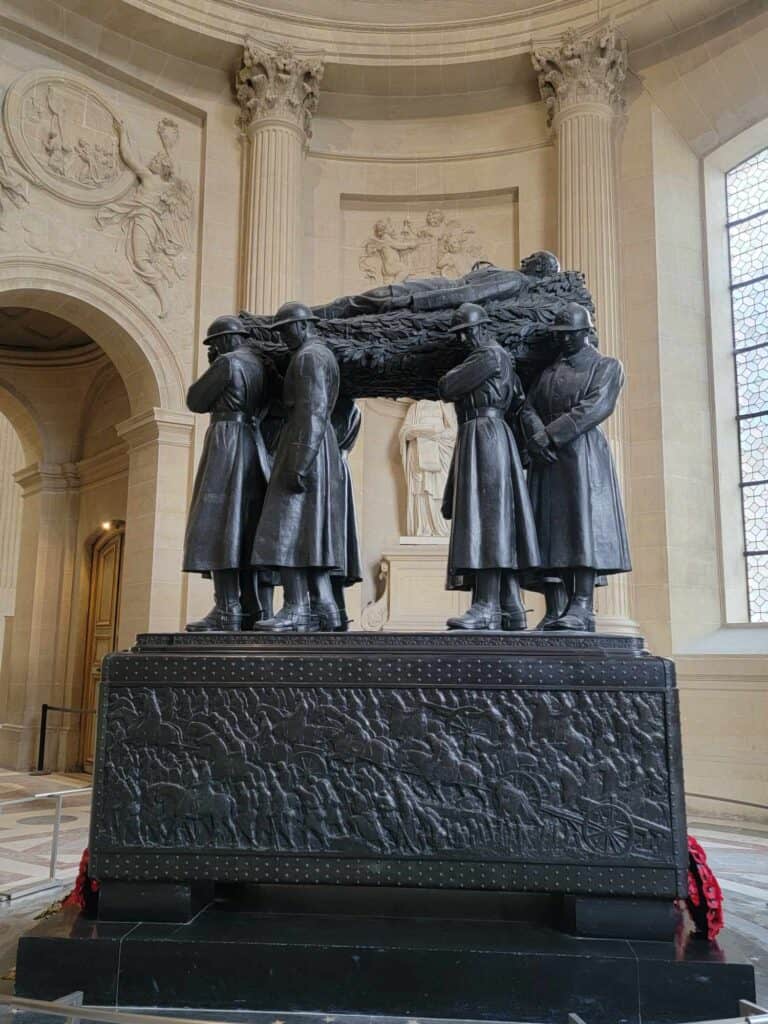
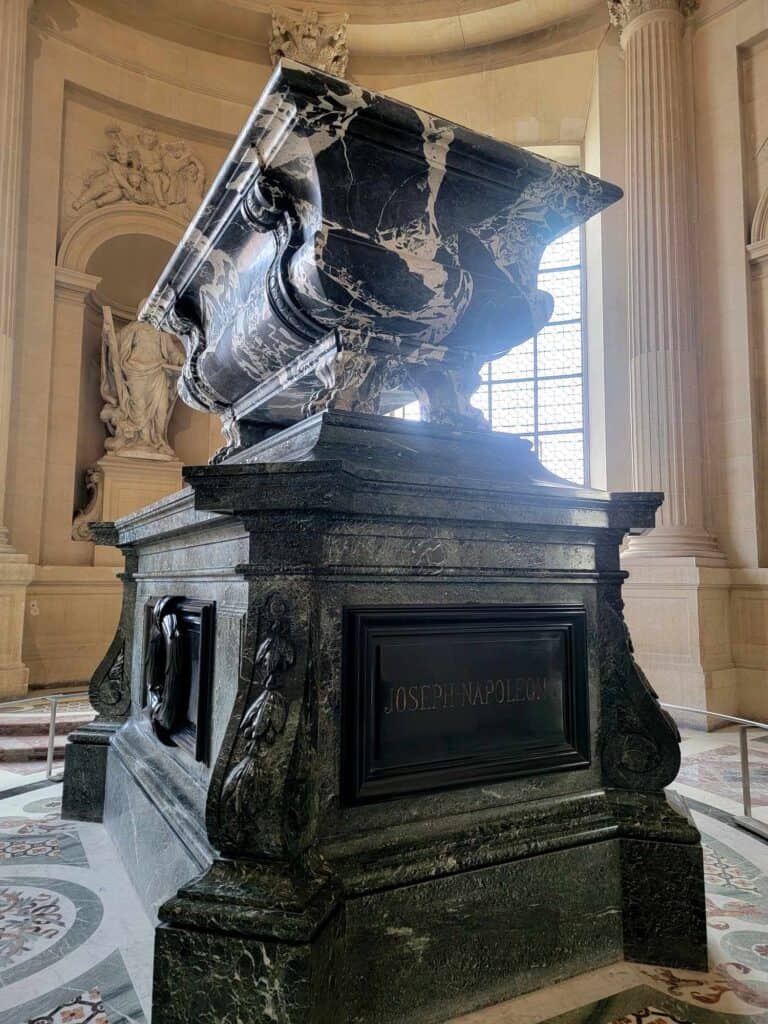
Napoleon isn’t alone in the Dôme, although he does occupy the spot directly under its apex. Other prominent military figures are also buried in the building including:
- Joseph Bonaparte – Napoleon’s elder brother and former King of Spain
- Jérôme Bonaparte – His youngest brother and former King of Westphalia
- Napoleon II (The “Eaglet”) – Napoleon’s son, originally buried in Vienna but moved to Les Invalides in 1940
- Marshals of France – The famous military commanders Turenne and Vauban
- Ferdinand Foch – The Supreme Allied Commander in WWI. This one is very moving, and shows Foch in bronze carried by his men, and encircled in marble inlays on the floor with the names of WWI battles.
- Sébastien Le Prestre de Vauban – France’s greatest military engineer
Tickets, Opening Hours, and Tours of Napoleon’s Tomb & Military Museum
⏱ Allow 45 minutes to an hour to see the Dôme with Napoleon’s tomb, and another 30 minutes to an hour to see the artifacts in the museum. We chose to see the artifacts first and finish up with the tomb and we were happy we did it in that order to finish with the big wow!
And of course, you could easily spend an entire day at the museum exploring the unbelievable medieval weaponry and armour, the World War I and World War II galleries, and items from every war and conflict in between.
Tickets:
- General admission: €15
- Purchase tickets at the information booth in the building next to the Dôme, or you can reserve them ahead of time which isn’t a bad idea during busy times.
- Tickets include access to both Napoleon’s Tomb and the Musée de l’Armée (The Military Museum)
Opening Hours:
- Daily: 10:00 AM – 6:00 PM
- Last entry: 5:30 PM
- Closed: January 1st, May 1st, and December 25th
Tours of Napoleon’s Tomb:
- There are a variety of tours you can take to see Napoleon’s tomb. Some just include the museum, some include other Napoleonic sites, World War II sites, or even a Seine River cruise!
The Musée de l’Armée: Napoleon’s Personal and Military Artifacts
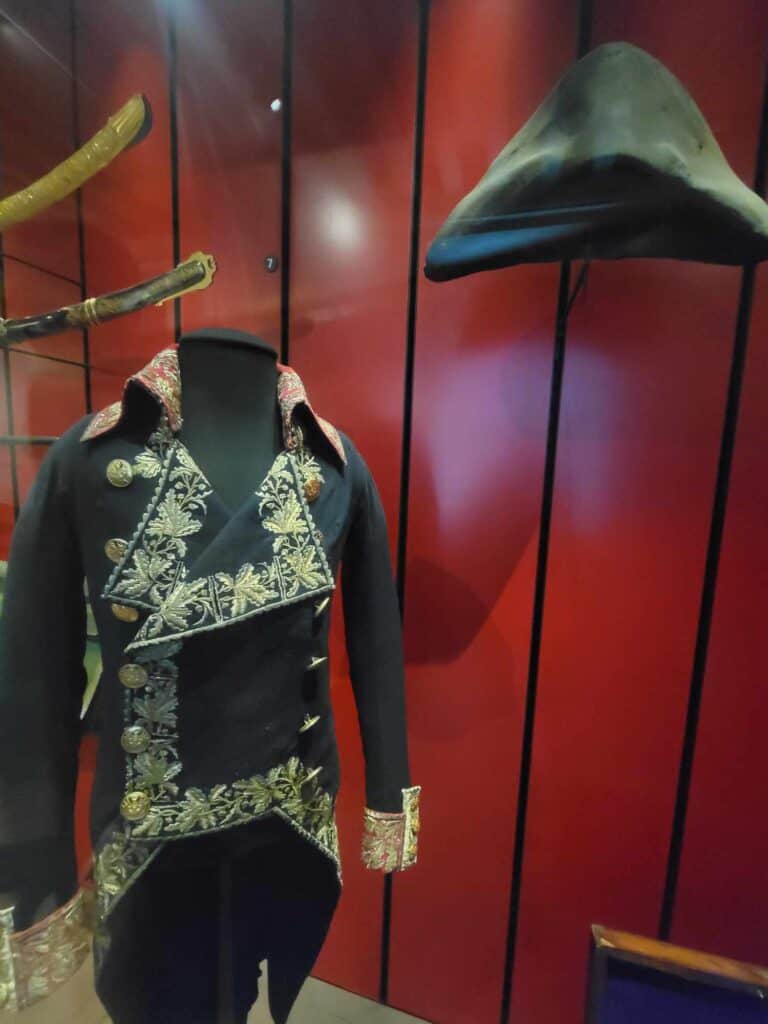
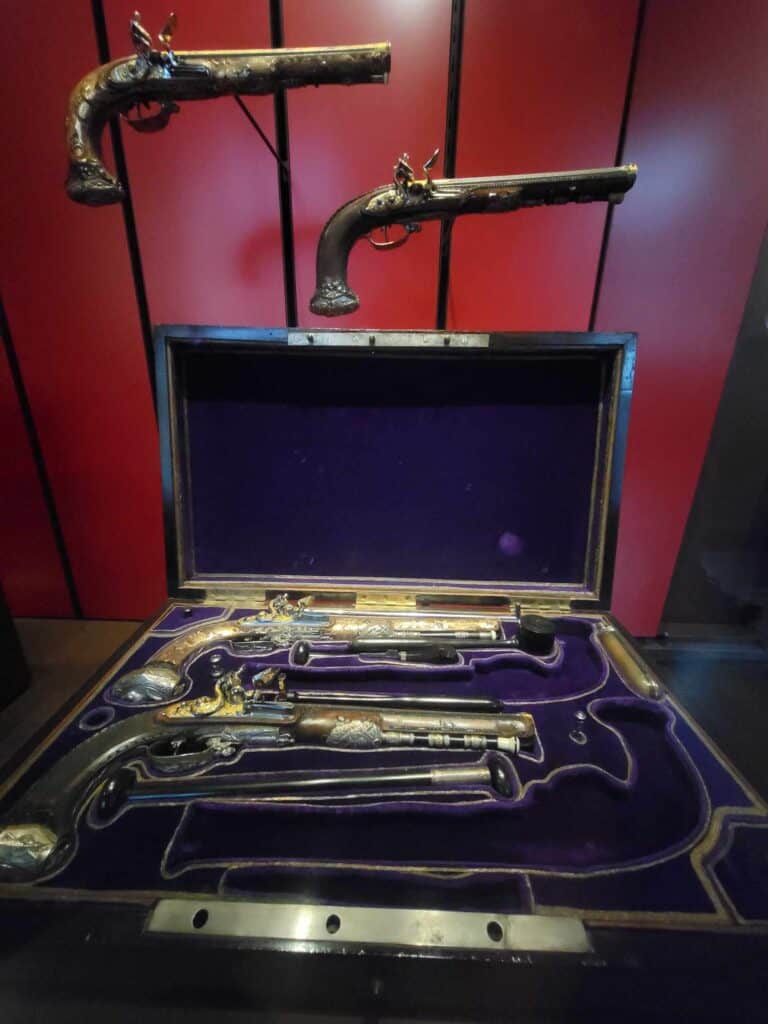
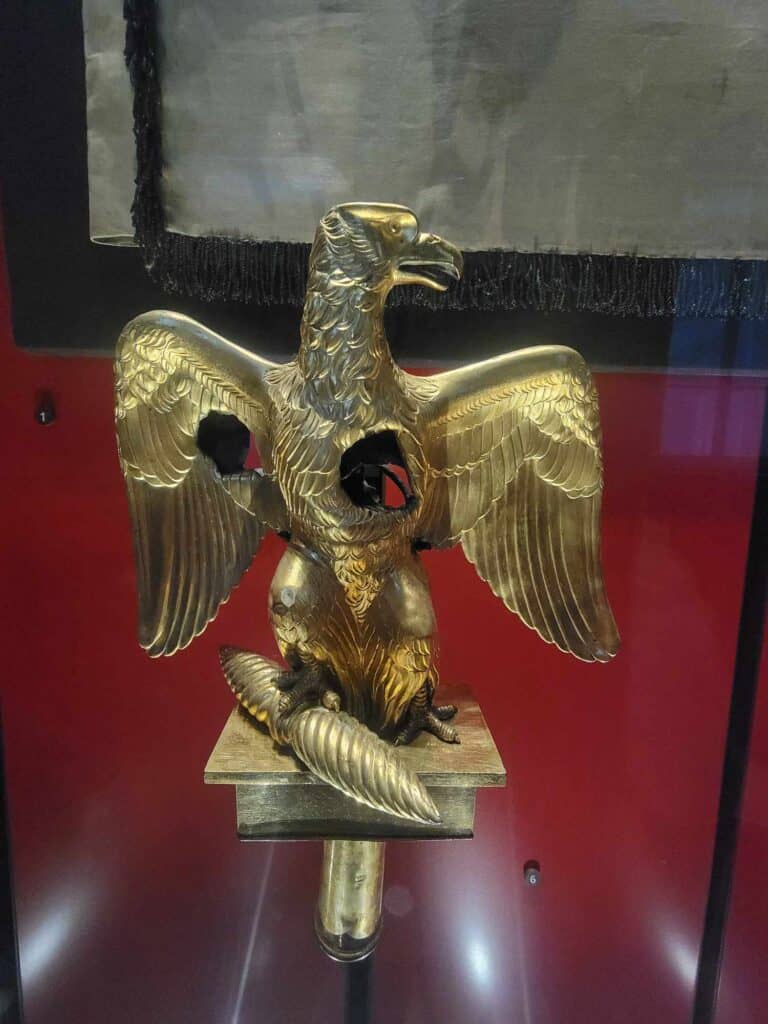
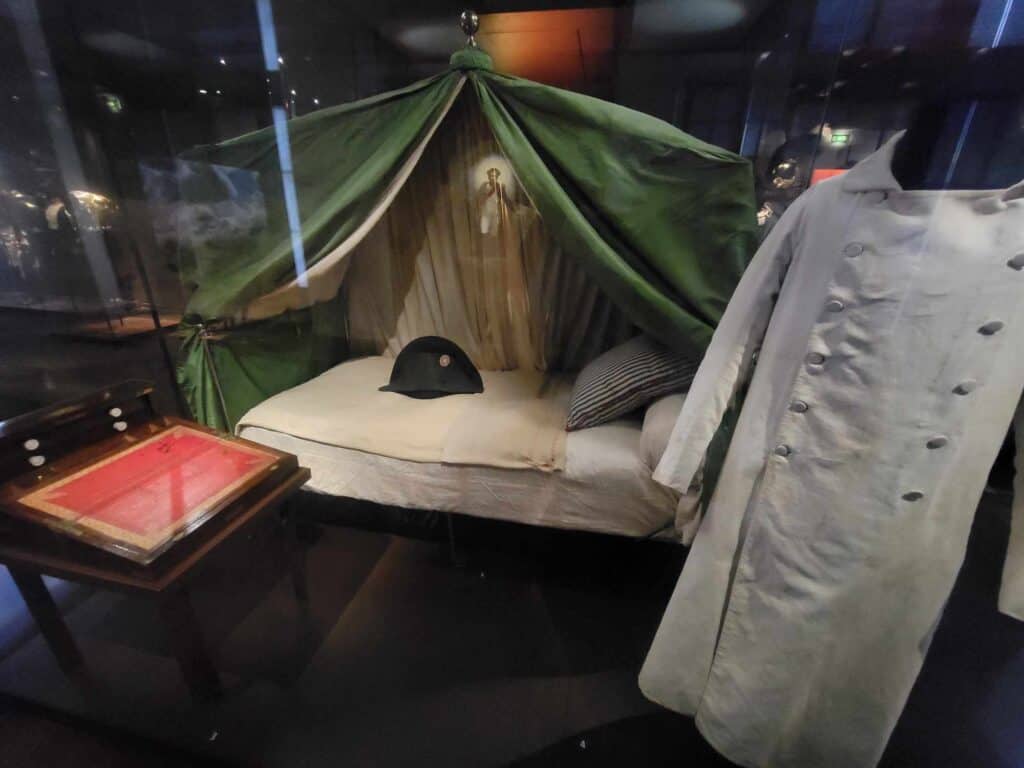
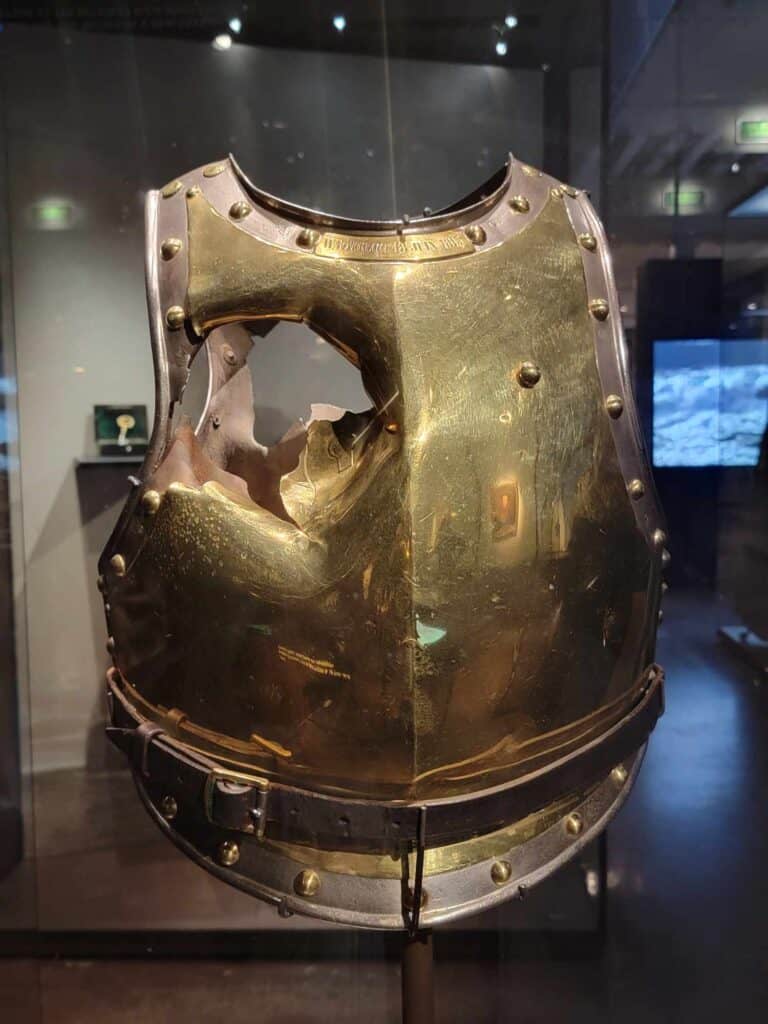
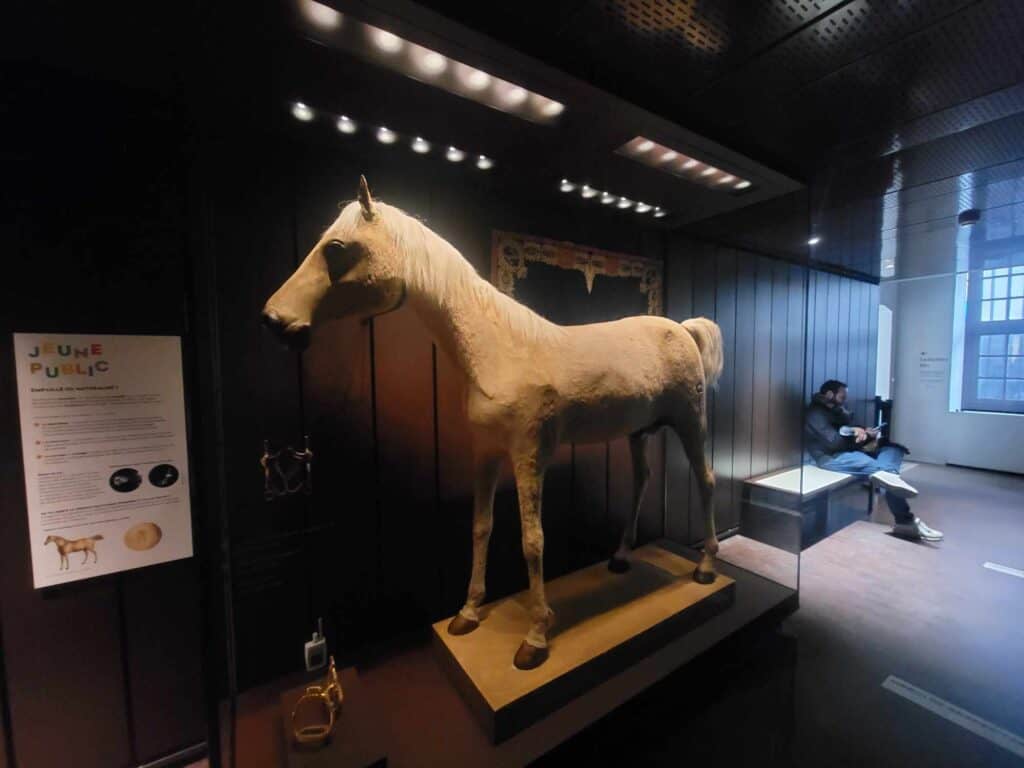
Adjacent to the Dôme that houses Napoleon’s tomb is the Musée de l’Armée, one of the world’s most impressive military museums where you can see:
- Napoleon’s iconic bicorne hats
- His campaign tent, bed, desk, and even his bathrobe
- His military uniforms and swords
- The taxidermied horse he rode at the Battle of Jena – yes really
- Cannons, battle flags, a spy glass, medals, and other Napoleonic artifacts
Why Visit Napoleon’s Tomb?
Even if you’re not a die-hard military history fan, the grandeur of Les Invalides and Napoleon’s tomb is worth experiencing. The combination of the beautiful monumental architecture, the military history, and Napoleon’s outsized legacy in shaping world events really makes for a visit you will not forget.
Bonus: Napoleon’s tomb is easy to pair with the Rodin Museum which is right across the street!
🌦 10-Day Weather Forecast for Paris
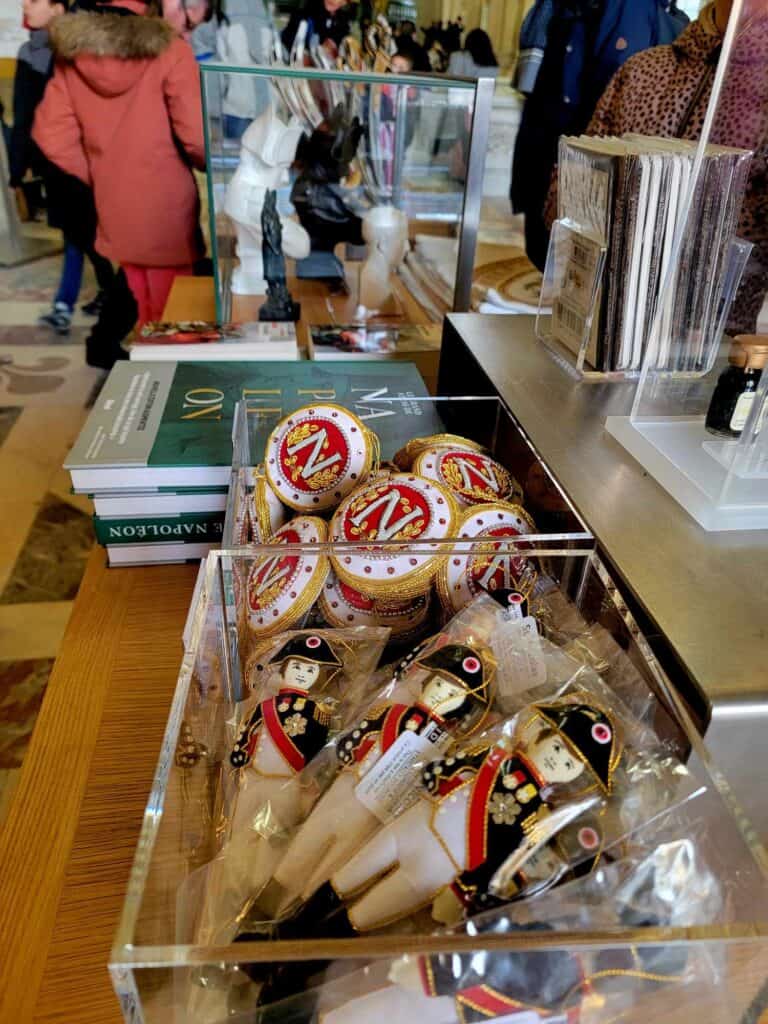
You May Also Be Interested in These Posts:
Is Versailles Worth It? Bastille Day in France
Visit General Pattons Grave in Luxembourg
Hack the Louvre! How to Visit the Louvre in 3 Hours
What to Expect at the New Museum of Urban and Street Art in Bitche
10 Best Things to Do in Reims France
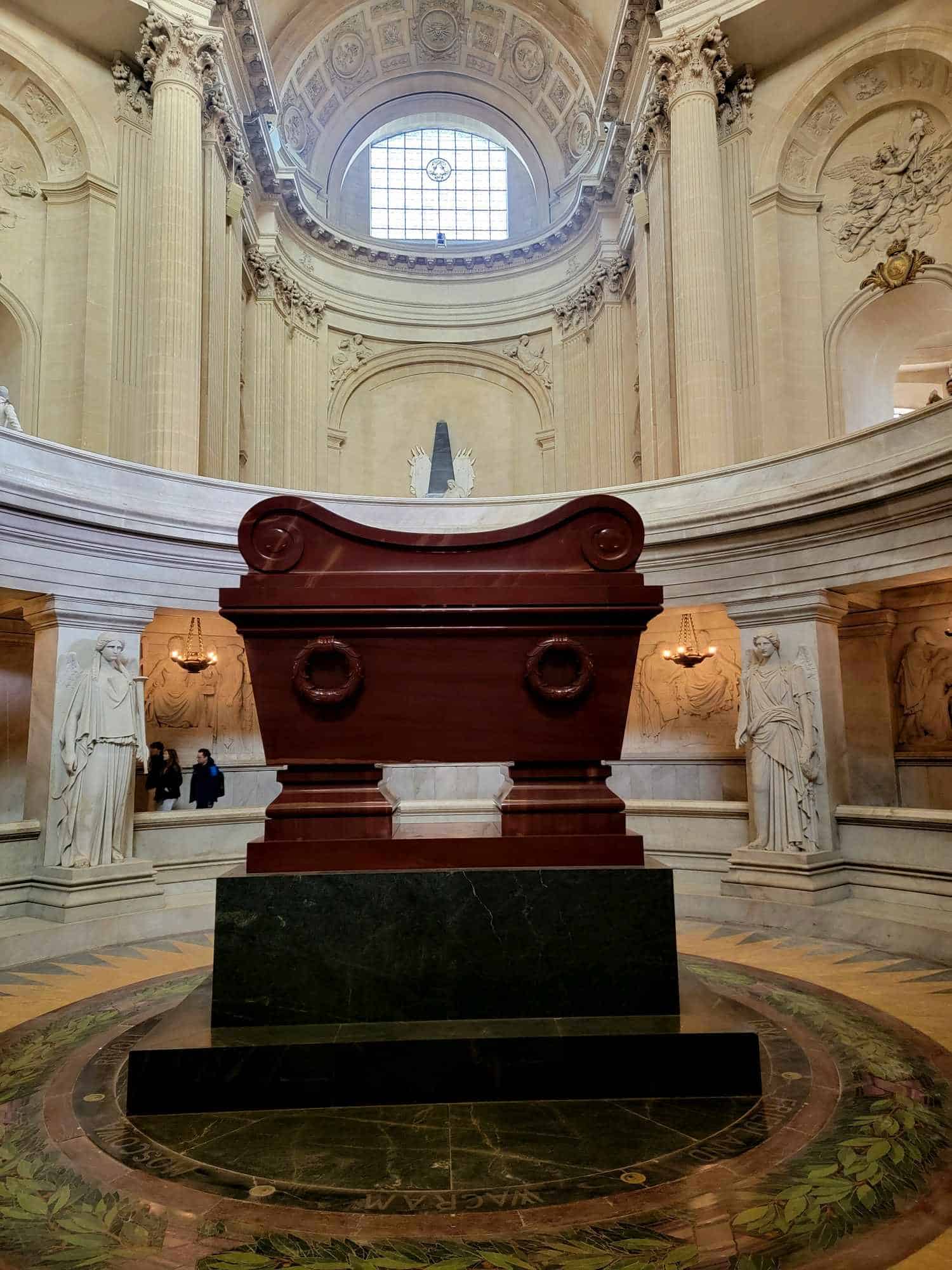
This was a great story for me. 1) My ancestry lies in Essen but have never been there. Now I feel as though I have a small visual of it. 2) I’m headed to Paris in July and had Invalides on my list of things to see if I have extra time. This has now been moved to my must see, along with the Rodin Museum.
Thanks. I love your channels. 🥰
Thank you! That makes me so happy. 🙂 I hope you have a fabulous trip, and enjoy the museums!